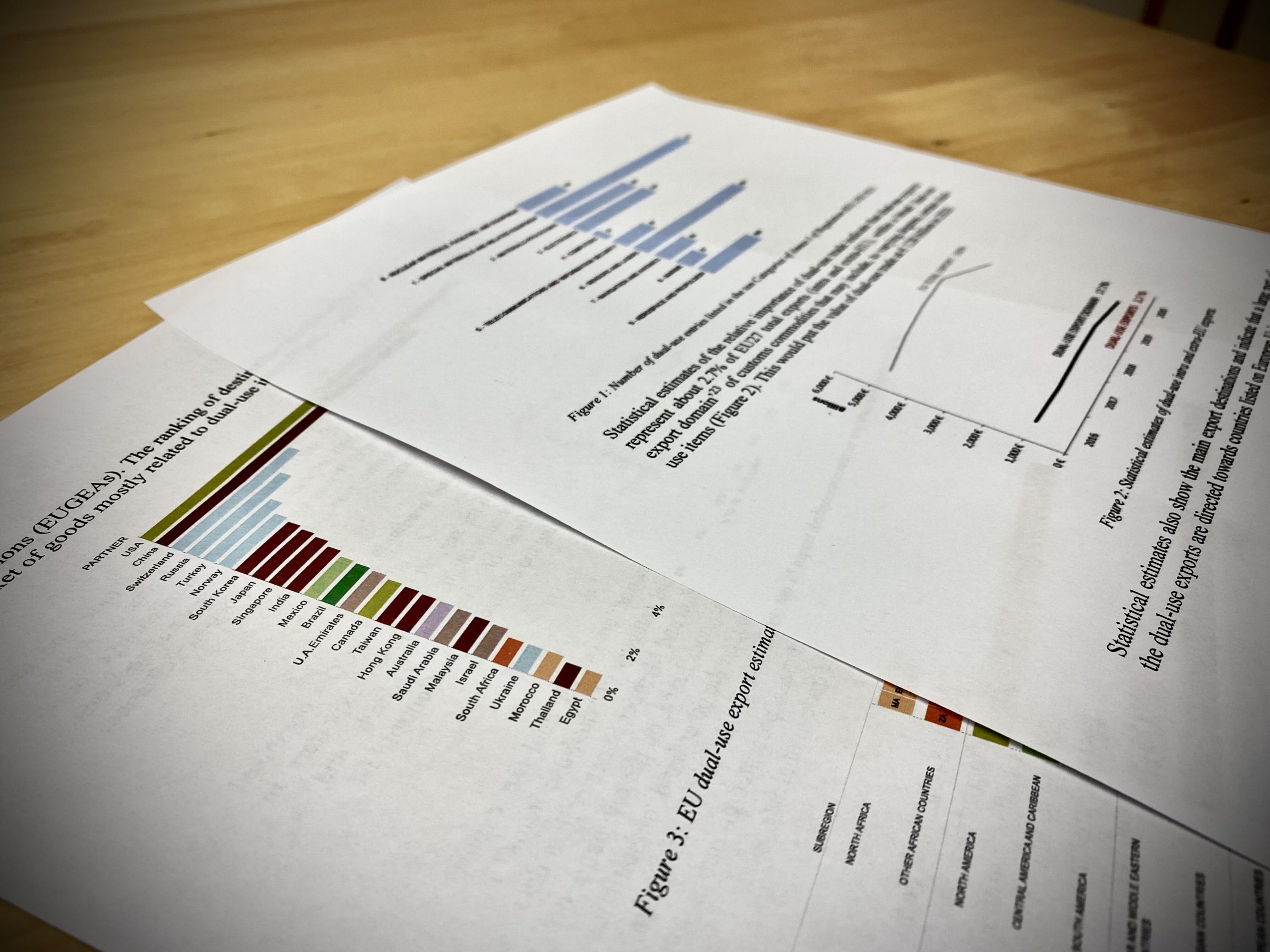Report on the implementation of the new EU dual-use Regulation
On 2 September 2022, the Report on the implementation of the new EU dual-use Regulation 2021/821 (hereinafter “the Regulation”) was issued.[1]
The document details the implementation of the Regulation[2] with regard to the evolution of the policy and regulatory framework, the activities of the dual-use Coordination Group and the EU export controls key data. It covers the implementation of the Regulation in 2021 and provides aggregated export control data for 2020. As a consequence, the effects of the Russia’s war in aggression of Ukraine on the EU export control system are not reflected.
For the very first time, the Report has been adopted together with the Annual Report on FDI Screening[3]with the reason that both provide strategic trade and investments controls to ensure security in the EU.[4]
Concerning the evolution of the policy and regulatory framework, the Report emphasises both the new Export Control Regulation, which entered into force on 9 September 2021, and some new areas of implementation for Member States and the Commission (e.g. enforcement, transparency, capacity building). The EU Control List in Annex I was amended once in 2021 to reflects the developments in multilateral export control regimes. The consultations and outreach’s engagement with industry and civil society stakeholders for the reporting year is crystalised in both the targeted consultation launched by the Commission and the Export Control Forum. The report also highlights the role of the recently set up EU-US Trade and Technology Council (“TTC”). It presents its functions, bodies and objectives as well as the recent outcomes (issuing from the October 2021 Joint Stakeholders meeting and the December 2021 Public Consultation). The TTC represents the EU’s active engagement in the cooperation with third countries in export control as it is aimed at ensuring greater coordination in approaches on trade and technology issues. With concern to measures of national implementation of the Regulation’s specific provisions for the reporting year, they have been published in the Information Note of the 8 February 2021. While, as regards national enforcement measures, the data published in the previous annual export control report remains valid.
With respect to the Dual-Use Coordination Group (DUCG)’s activities (made up of experts from the Commission and Member States), it conducted general information exchange on export control issues and national implementation measures, besides providing support in collecting information on licensing data. The DUCG also supported the Commission supervising the exchange of information on implementation and enforcement. In this regard, there seems to have been an increase in the export controls breaches compared to the data provided by the 2021 report.[5] The DUCG also conducted a technical exchange of information on the application of controls on cyber-surveillance technologies in 2021. The data provided shows a decrease in the number of licenses for the export of such technologies.[6] The DUCG also engaged in the technical exchange of information on implementation issues: it set up dedicated expert groups to implement the new Regulation’s requirements; it provided technical expertise supporting the EU control list updates; he launched consultation on information regarding EU General Export Authorisations (EUGEAs) and global licences and established a mechanism of consultation between competent authorities on global licences issues. It is noteworthy the DUCG expanded the EU export control “institutional infrastructure” by creating expert groups commissioned to issue new guidelines, policies etc. The Surveillance Technology Export Group (STEG) was reactivated and its scope aligned to the new Regulation provisions. Through the STEG, experts from Member States can contribute to the developments of EU export controls on cybersurveillance technologies, share information on risks associated with such exports and develop guidelines on due diligence addressed to exporters. The Technical Expert Group on the development of guidelines for dual use research (TEG-DUR) finalised the EU Guidance on internal compliance programmes for research involving dual-use items which was published in September 2021[7]. In consideration of the fact that the Guidance is not binding, among other things, the DUCG started developing a plan of actions to support the implementation and monitoring of the guidance. A new Technical Expert Group on emerging technologies (ETEG) was launched, aiming at facilitating the information exchange on the challenges and risks associated with the export of such technologies. With regard to transparency and coordination, the DUCG endorsed the Terms of Reference for a Technical Expert Group on data collection and transparency (TEG-Transparency) and for an Enforcement Coordination Mechanism (ECM), dedicated to the exchange of best practices and information among EU licensing and enforcement authorities. Lastly, the DUCG engaged in initial discussions for the establishment of a Technical Expert Group on capacity-building aiming at supporting training and sharing of expertise within the EU dual-use community. Furthermore, the DUCG supported the Commission in the development of the Dual-Use e-System (DUeS), a crucial platform for the implementation of the Regulation. In fact, it allows a more agile and efficient sharing of information on different areas such as the intra-EU transfers and denials, among other things.[8] Interestingly, the platform will also specifically support the information-exchange with the UK under the NI Protocol.[9] The dual-use eLicensing system became operational in 2021 in some EU Member States and the Commission is currently considering whether providing the eLicensing tool to partner countries (e.g. Bosnia and Herzegovina). Taking a step further, the eLicensing project is aiming at connecting the eLicensing system with national custom systems. Finally, a new “eLicensing bridge” project is launched to connect national licensing systems to customs systems. With respect to capacity building, the report mentioned the technical seminar organized by the Commission’s Joint Research Centre together with the US Department of Energy addressed to licensing authorities and focusing on cyber-surveillance, cryptocurrencies, blockchain and proliferation financing. Compared to the information on the DUCG activities provided by the previous reports, the 2022 report does not make any reference to the EU-Dual-use Pool of Experts[10] which provided support to competent authorities in the assessment of specific licensing case upon request of Member States.
With regard to key data on EU export controls, it continues to be a challenge to collect them as “dual-use items” is not an official category in the different official statistics. Therefore, data are based on the licensing data collected by competent authorities and on statistics for export declarations to EU customs. However, these latter refer exclusively to dual-use goods, they exclude services and intangible technology transfers related to dual-use trade goods. For 2020, the report estimates that dual-use exports (within a broad ‘dual-use export domain of customs commodities) represent about 2.7% of the intra and extra-EU27 total exports, corresponding to a value of € 128 billion of dual-use trade. In terms of export destinations, the data shows that a large part of dual-use trade is directed towards countries listed in the EUGEAs,[11] while concerning destinations of export licenses the main ones are China, the US, Taiwan, South Korea and Russia.[12] With regard to intra-EU destinations of authorisations, the top five are France, Sweden, Finland, Germany and Spain. Data on intra-transfer alone were not made available on previous reports. As regards licenses data, it should be noted that not all Member States collect all data and that is also why they represent approximate estimates. For the reporting period, the total value of applications reached EUR 38.4 billion, while the authorised dual-use trade amounted to EUR 31 billion. In terms of export denials, they represent the 1.4% of the value of controlled dual-use exports in that year, and 0.03% of total extra-EU27 exports (559 denials were issued in total for the reporting period)[13]. This year the data do not include those provided by the UK due the Brexit and that is why it shows a certain decline. Concerning licenses data by category of dual-use items as listed in the ten categories of Annex I, the main categories by value in 2020 were, in order: Category 5 (Telecommunication and ‘information security’); Category 0 (Nuclear materials, facilities and equipment); Category 3 (Electronics).
In conclusion, and compared to the previous reports, the 2022 report provides updated data on the areas mentioned in the previous documents, yet excluding that related to EU-Dual-use Pool of Experts. Conversely, the last report includes information on the TTC, on new technical expert groups, on intra-EU destinations of authorisations, on authorisations by the 10 categories of Annex I of the dual-use regulation and on the Regulation implementation indicative timeline. Last but not least, the recognition of the strong interplay between strategic export control and FDI screening is emphasized through the adoption of the two documents together.
[1] Report from the Commission to the European Parliament and the Council on the implementation of Regulation (EU) 2021/821 setting up a Union regime for the control of exports, brokering, technical assistance, transit and transfer of dual-use items, (2.9.2022). Available at https://data.consilium.europa.eu/doc/document/ST-12045-2022-INIT/en/pdf
[2] Regulation (EU) 2021/821 of the European Parliament and of the Council of 20 May 2021 setting up a Union regime for the control of exports, brokering, technical assistance, transit and transfer of dual-use items (recast) (OJ L 206, 11.6.2021). Available at:https://eur-lex.europa.eu/eli/reg/2021/821/oj .
[3] Report from the Commission to the European Parliament and the Council, Second Annual Report on the screening of foreign direct investments into the Union , 1.9.2022. Available at: https://eur-lex.europa.eu/legal-content/EN/TXT/PDF/?uri=CELEX:52022DC0433
[4] Report, supra, p. 1.
[5] In 2020, 78 breaches of export controls regulations were recorded, while eight administrative penalties and seven criminal penalties were applied by national law enforcement authorities In 2019, 144 breaches of export control regulations were recorded while eight administrative penalties and 16 criminal penalties were applied by national law enforcement authorities. Source: Report from the Commission to the European Parliament and the Council on the implementation of Regulation (EU) 2021/821 setting up a Union regime for the control of exports, brokering, technical assistance, transit and transfer of dual-use items, (2.9.2022, p. 7). Available at: https://trade.ec.europa.eu/doclib/docs/2021/november/tradoc_159936.pdf
[6] In 2020, the licences issued were 39 and the denials 32; in 2019, the licences issued were 44 and the denials 32.
[7] Commission Recommendation (EU) 2021/1700 of 15 September 2021 on internal compliance programmes for controls of research involving dual-use items under Regulation (EU) 2021/821 of the European Parliament and of the Council setting up a Union. Available at : https://eur-lex.europa.eu/legal-content/EN/TXT/PDF/?uri=CELEX:32021H1700
[8] The eLicensing systems allows to reduce the administrative burden associated with controls, both for exporters and competent authorities and to replace off-line systems for more swift and easier exchange of information, including the reporting of licensing data to the Commission, and bringing further potential for exchange of data across the EU.
[9] The new functionality supporting information-exchange with the UK under the NI Protocol was introduced in January 2021 in consideration of Brexit.
[10] The EU Dual-Use Pool of Experts operated by the Commission’s Joint Research Centre and experts made available by Member State.
[11] The top 25 export destination countries are: USA, China, Switzerland, Russia, Turkey, Norway, South Korea, Japan, Singapore, India; Mexico, Brazil, A.A. Emirates, Canada, Taiwan, Hong Kong, Australia, Saudi Arabia, Malaysia, Israel, South Africa, Ukraine, Morocco, Thailand, Egypt.
[12] The main extra-EU destinations of authorisations in 2020 are: China, USA, Taiwan, South Korea, Russia, Saudi Arabia, Brazil, Mexico, Switzerland, Turkey, Japan, India, U.A. Emirates, Israel, South Africa, Singapore, Malaysia, Hong Kong, Thailand, UK, Algeria, Australia, Qatar, Egypt, Canada.
[13] In 2018, 791 denials werre issued, representing about 0.69% of the value of controlled dual-use exports a,d 0.02% of total extra-EU exports.



No responses yet